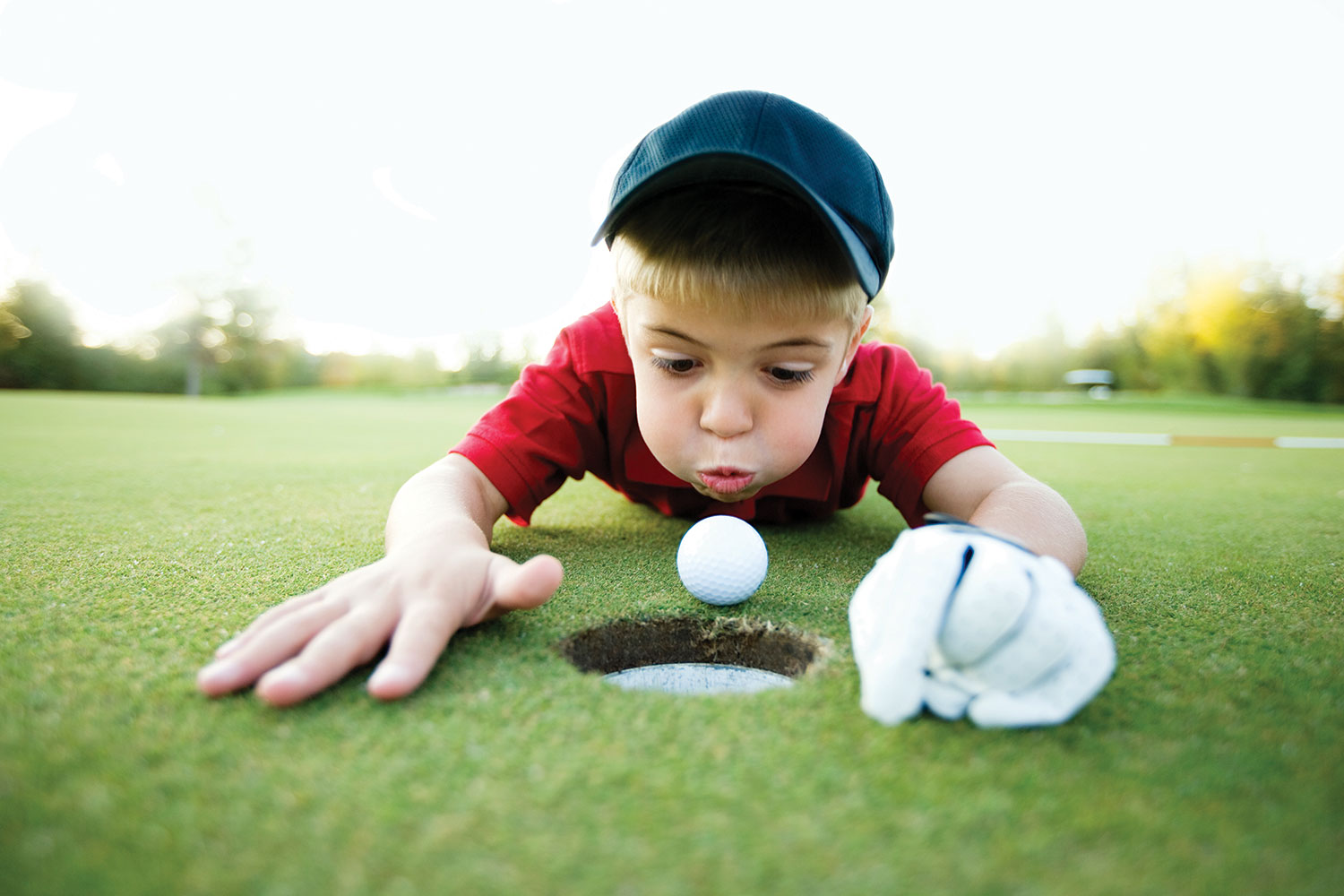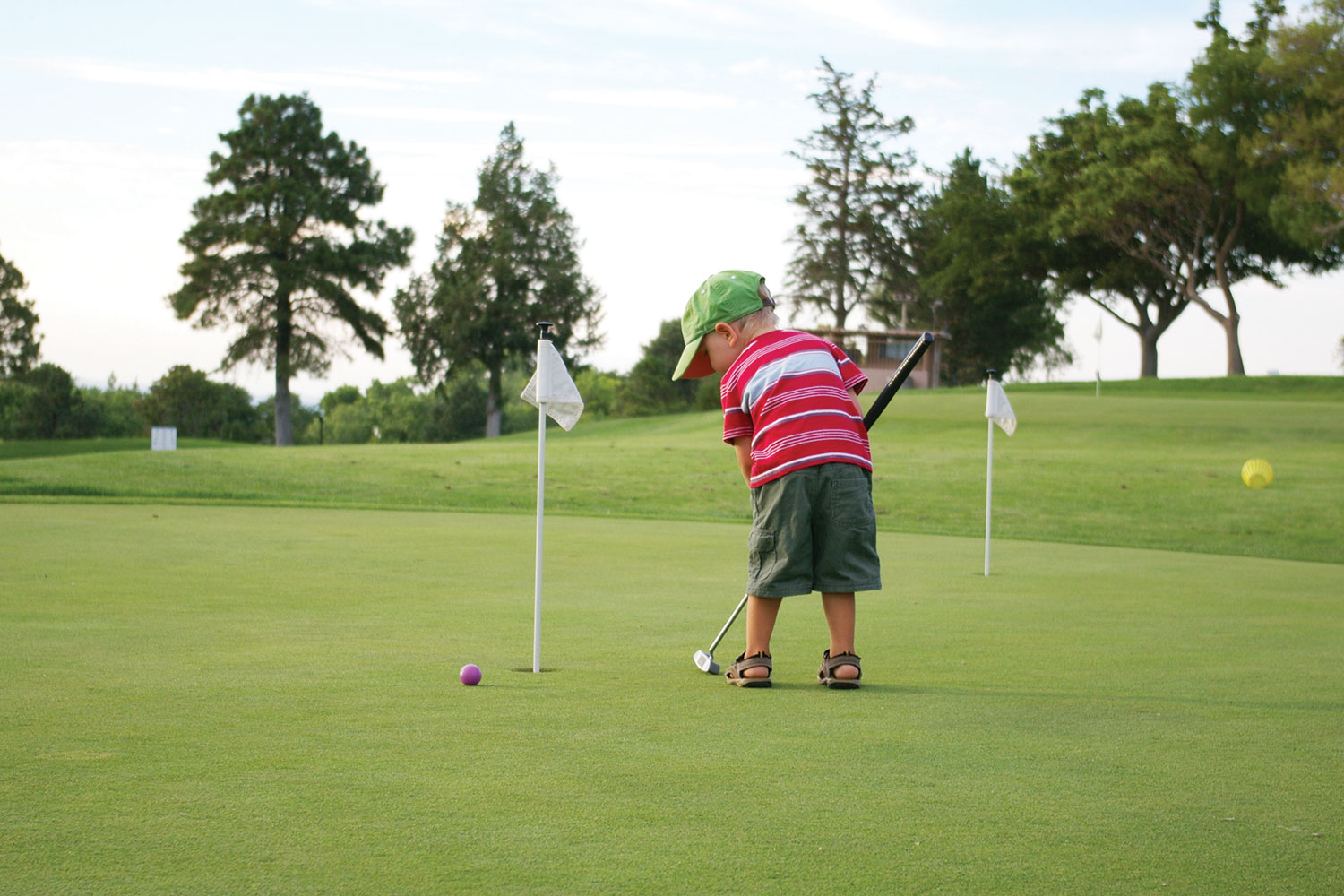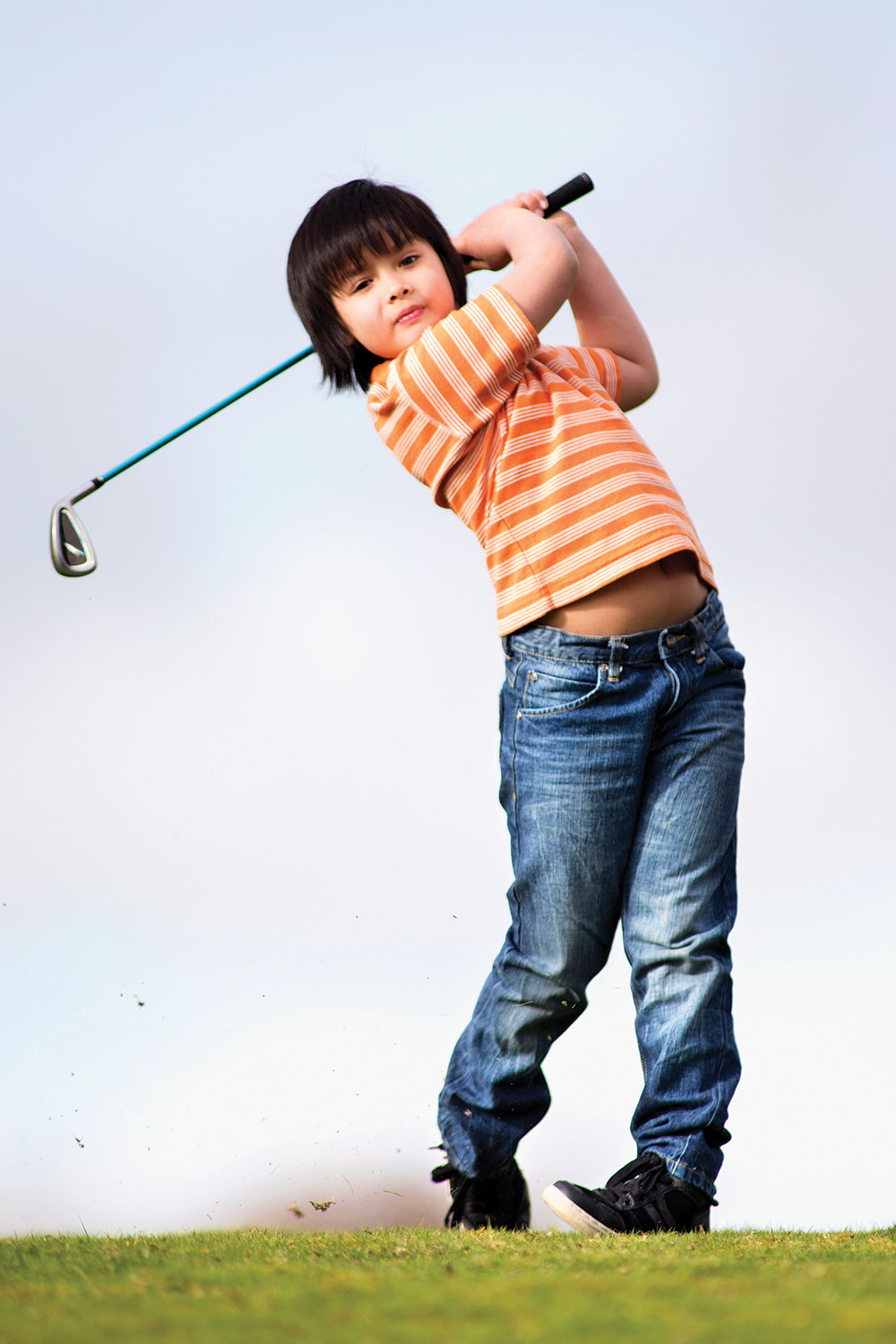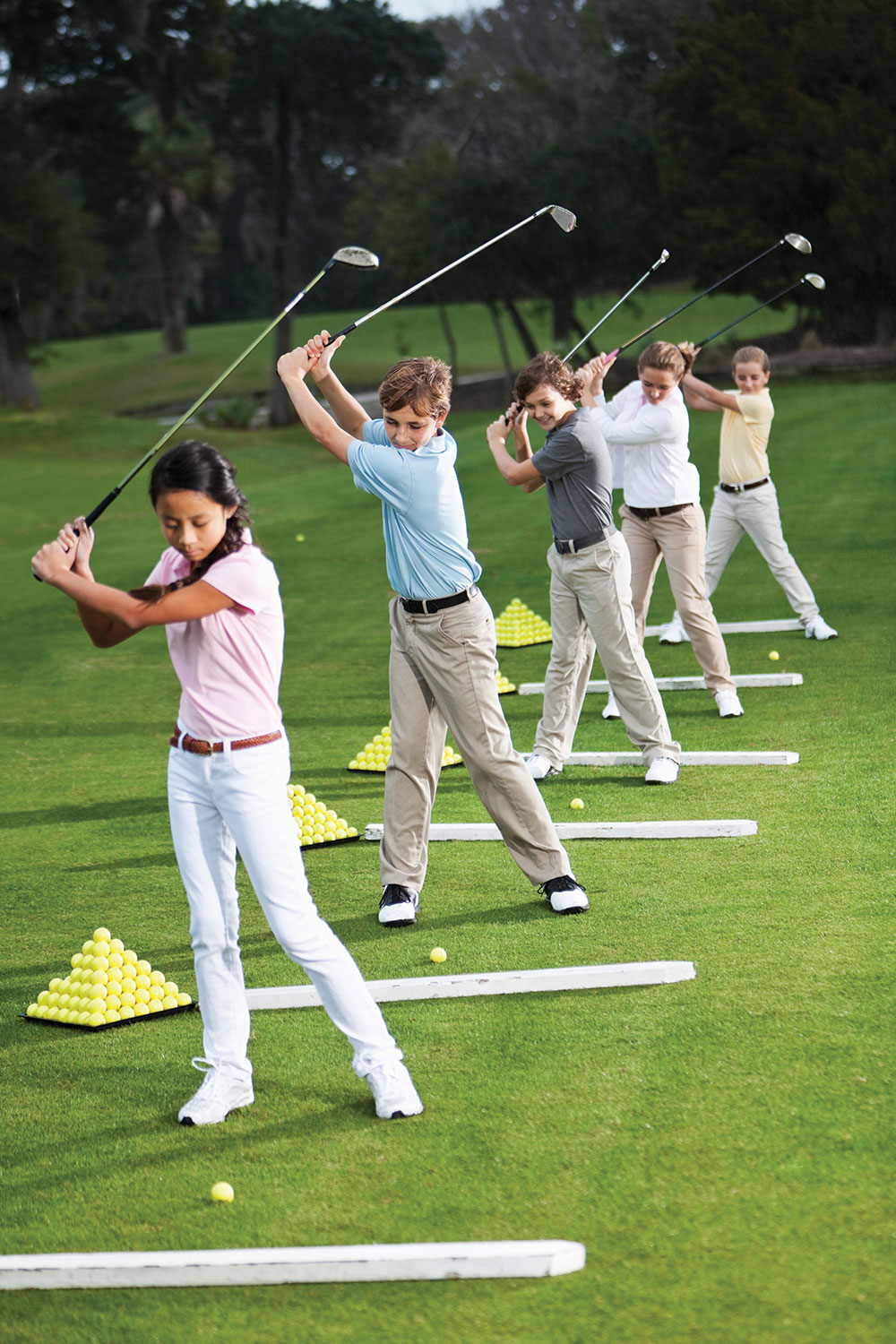 I’VE got to see this.”
I’VE got to see this.”
Glenda McDade knew before her husband Denis that the innocent request from their two young children to learn how to play golf would be a challenge for her teaching pro husband that he hadn’t yet experienced in his career. As a staff member of the acclaimed Victorian Institute of Sport golf program, McDade was overseeing the development of the finest young golfers in the state and assumed teaching Laura, 7, and Connor, 5, would encompass similar principles, simply on a slightly smaller scale. He was wrong.
“Glenda knew before I did that the way I deal with an elite player was never going to work with young kids,” McDade tells Australian Golf Digest. “We went down to the range and I started trying to coach them like I’d coach any other golfer and within 10 minutes I thought to myself, I have no idea how I’m going to teach these kids how to play golf.”

Like teaching your children to tie their shoelaces or drive a car, putting what you innately know to be true into words that children can understand is one of parenting’s great challenges and few things test a kid’s patience more than being taught how to swing a golf club, especially by mum or dad. Whereas youngsters introduced to other sports get to play even modified formats from a young age, golf requires the development of a certain level of skill before the game can even be played and thus enjoyed.
“That unstructured play is really the laboratory for kids when
they are in that discovery phase … That’s them discovering,
experimenting, figuring things out.”
– Denis McDade
McDade recognised that rather than focusing on the golf swing itself, he had to engender fundamental movement skills in children that could later be applied to playing golf and, more than anything, encourage them have fun at the golf course.
“With that emerging demographic of young player their golf program should just look like they’re doing a whole lot of play,” says McDade, who is now the head of the Titleist Performance Institute Junior Advisory Board. “You might put hula hoops on the green and play battleships by rolling tennis balls or golf balls across the green.
“When you finish the game you can say to the kids, ‘Let’s try it with putters now.’ That unstructured play is really the laboratory for kids when they are in that discovery phase. If we had an activity and they wanted to throw it left-handed instead of right-handed or face away from the target and throw it over their shoulder to the target, I always let them do that because what looks like play to us is the work of young kids. That’s them discovering, experimenting, figuring things out.”
As national coach for the GolfWA high performance team, Ritchie Smith has overseen the development of the brightest young crop of male and female players in the country. He too encourages less structure in the introductory phase. A father to two daughters, Smith also believes the lack of free play for children of today is inhibiting their athletic development and says kids must fall in love with golf before they will express any desire to become good at it.

“If you take your kids to the driving range, just let them have a hit. You don’t have to tell them anything,” Smith says. “With my two girls I don’t tell them anything. I just let them have a hit and go and find it and hit it again. I think that’s the best way of actually learning and the best way of actually enjoying it.”
And whether you want your son or daughter to be good or not, both McDade and Smith stress the importance of allowing your children to play a multitude of different sports at a young age. Not only will it promote those fundamental movement skills necessary in all sports but it will ensure that whatever they try their hand at, including golf, they will be better prepared to perform the skills required.
“Specialisation doesn’t work, it just doesn’t work at a young age,” says Smith. “Lots of parents have their kids as single-sport players at 8, 10, 12 years of age and it doesn’t work. Most of the really good golfers played six sports before the age of 12 and then they played two sports from 14 to 16 and then past the age of 16 they specialised.
“If I wanted my kid to be good at golf I would definitely get them to do a martial art. Even something like rock climbing. We’ve got a 14-year-old kid who is off 1 or scratch now and when he first came here I told him he needed to go and climb trees for a couple of hours a week, because he wasn’t playing any other sports.”
More Fun With Friends
We’ve all had grand visions of strolling through life’s fairways and greens with our children by our side but the cold reality for parents is that kids have more fun with their friends, and golf is no different.
In a sport that by and large fails to provide a welcoming environment for people under the age of 12, the prospect of spending four hours with people old enough to be your grandparents instead of people your own age has always been a barrier. Some clubs have thriving junior programs which encourage mateship among like-minded kids of similar ages, but many kids face the daunting prospect every Saturday of being the sole representative in their demographic.
“If I wanted my kid to be good at golf I would definitely get them to
do a martial art. Even something like rock climbing” – Ritchie Smith
For more than 30 years, Jack Newton Junior Golf has been bringing junior golfers together from throughout New South Wales to play against each other in age tournaments while also working within schools and introducing programs that allow kids to play with kids on a more regular basis.
One of JNJG’s latest initiatives is the ‘Juniors on the Move’ program that conducts a monthly nine-hole tournament for kids aged 7 to 12 at different courses in Sydney, the Illawarra, Central Coast and Hunter regions who are members at clubs with only a small number of juniors. A similar style program is also run in the Northern Rivers region of NSW where 10 clubs host rotating monthly events in 18, nine, five and three-hole formats for kids under the age of 18.
 “Kids play sport because there are other kids there, so we provide facilities and events where they know there will be other kids there,” says JNJG chief executive Peter Van Wegen.
“Kids play sport because there are other kids there, so we provide facilities and events where they know there will be other kids there,” says JNJG chief executive Peter Van Wegen.
“Golf tends to be a little bit isolated. I was lucky where I grew up that there were 10 or 12 juniors all around the same standard, so there were always kids at the club, but there are a lot of clubs these days that only have one or two juniors. It’s not a lot of fun waking up on a Saturday morning to play with three blokes in the comp who are 50-plus.”
It’s that element of fun with their friends that McDade says was the cornerstone of his coaching philosophy for young golfers.
“I talk about the five reasons kids play sport and the first of those is that it’s got to be fun. If it’s not fun, they’re out,” he says. “Second is that they do it with their friends. You might have visions of them playing with you but they’d actually rather do it with their friends. It’s just the way they’re wired.
“Over time, the reason my kids fell in love with the game is that they got to know kids there and they became their golf friends. It was always fun, it always felt like it was there for them and they were never pressured to compete. Kids will innately compete against each other and over time it just became one of those activities that they loved.”
And as hard as it may be to hear, the best support a parent can provide sometimes is to make sure they are not intruding on their child’s sporting activity. Our desire to share the experience comes from a place of good intent but in many instances, it can actually serve as a deterrent to the enjoyment you were hoping your child to have in the first place.
There are a lot of clubs these days that only have one or two juniors.
It’s not a lot of fun waking up on a Saturday morning to play with
three blokes in the comp who are 50-plus – Peter Van Wegen
“It took me a long time to figure it out but as a coach, whether you like it or not, the parents are going to be involved,” offers McDade. “Because our program looked so different from any kind of normal golf lesson, we told the parents that the kids would look like they were playing but explained the science behind what we were doing. That parent education was absolutely key. The parents need to be on board.”
Adds Smith: “If they are getting a lesson, go and have a coffee. Come back with five minutes to go and tell them they’re doing great. That’s all you have to do. Even better, just say to them, ‘Hope you’re having fun.’”
And the payoff if your child falls hard for the game is one of the proudest parenting moments you will have, even if it doesn’t necessarily include you. McDade’s most treasured memory of playing golf with his late father David was a round at Hyatt Coolum on the morning of his and Glenda’s wedding day, but he says watching Connor, now 17, and Laura, 19, walk off down the first fairway at Yarra Bend Golf in Melbourne together six years ago gave him a moment he will also never forget.
“They went off and played nine holes together and when they were coming back in I could see them laughing and giggling and carrying on,” McDade recalls. “That was a pretty special moment. That they had got to the stage where they can actually play the game, they want to play with each other and they don’t need me. I’ve played with them a number of times but when they went off to play together, hit it off the tee and walked down the fairway together, that was a good dad moment.”

Back To School
There is a metaphorical fight happening in the schoolyards across Australia for the sporting allegiances of our children and golf is doing what it can to stay in there swinging.
The introduction of the MyGolf program by Golf Australia and the PGA of Australia provided an entry-level product to golf at existing golf centres to help boost participation numbers that are so crucial in the issuing of government funding as well as a nationwide program attractive to potential sponsors.
When MyGolf launched in 2014, it saw a total of 3,480 participants take part, a number that has grown to 9,674 in the past 12 months with an overall target of 30,000 participants at the end of the 2020/2021 period.
Golf Tasmania has reported an extraordinary increase in MyGolf participants from 61 in 2015/2016 to 405 this past year, while in Victoria there were 1,211 boys and 415 girls who took part in Golf Victoria-sanctioned handicap events and another 537 boys and 214 girls playing in non-handicapped Stuart Appleby Rookie events.
GolfWA boasts more than 5,000 participants in its primary school program in addition to 160 players in the Smarter Than Smoking GolfWA Junior Tour and 646 MyGolf participants thus far in 2017.
In Queensland, there are 600 members of the Junior Golf Queensland initiative in addition to the ‘Pee Wee  Pennants’ series launched almost three years ago, but it is the MyGolf Schools program that promises to hit the critical mass.
Pennants’ series launched almost three years ago, but it is the MyGolf Schools program that promises to hit the critical mass.
The Australian Government’s Sporting Schools initiative provides schools with an inexpensive way to offer the game in a program designed to get more primary-school aged children engaged in sport.
Golf South Australia alone saw 9,000 students participate in the MyGolf Schools program over the past 12 months and has unveiled for the next year the District School and Club Visits program. It will provide a participation opportunity for primary school students who can then progress to their region’s school qualifying day and ultimately feed into the Golf SA Primary Schools Golf event each September.
Victoria had 10,414 children engaged through the My Golf Sporting Schools program last year and a further 1,704 boys and 819 girls playing in their primary schools golf event, while Golf Queensland estimates that up to 15,000 students are engaged in golf through the MyGolf Sporting Schools program.
“The school space is the way to go because all juniors are at school,” reasons Jack Newton Junior Golf chief executive Peter Van Wegen, who predicts that JNJG reached more than 20,000 school students in the past 12 months. “That is our market but there are 32 other sports knocking on the doors, so getting into schools is quite difficult. We really try to attract them in school programs, bring a group of them to the local club for a ‘Come and Try’ day and hopefully they’ll join up with the club’s program because there are other kids there taking part.”
Currently the only measure of junior participation across the country is through junior memberships and those engaged in the MyGolf program, which doesn’t take into account club-run junior programs for kids who are not members. Van Wegen is adamant that in order to better cater to the wants and needs of young Australians, we first have to better understand how many are playing golf and the various ways in which they are doing it.
“Blayney Golf Club out near Bathurst has 30 kids who go every Sunday to a program run by two of the local members, but they’re not members of the club as such,” says Van Wegen. “So there’s 30 kids that aren’t recorded in the participation numbers. That happens quite a lot.
“We need that information in this digital age so we can engage with them and their parents and provide them with advice if they are unsure of what the next step is for their kid who has shown an interest in golf. What we’re seeing is that junior participation is actually pretty strong and unless we start to record it accurately, we’ll never know what our market size is. We need to find a better way to record that.” – T.W.
